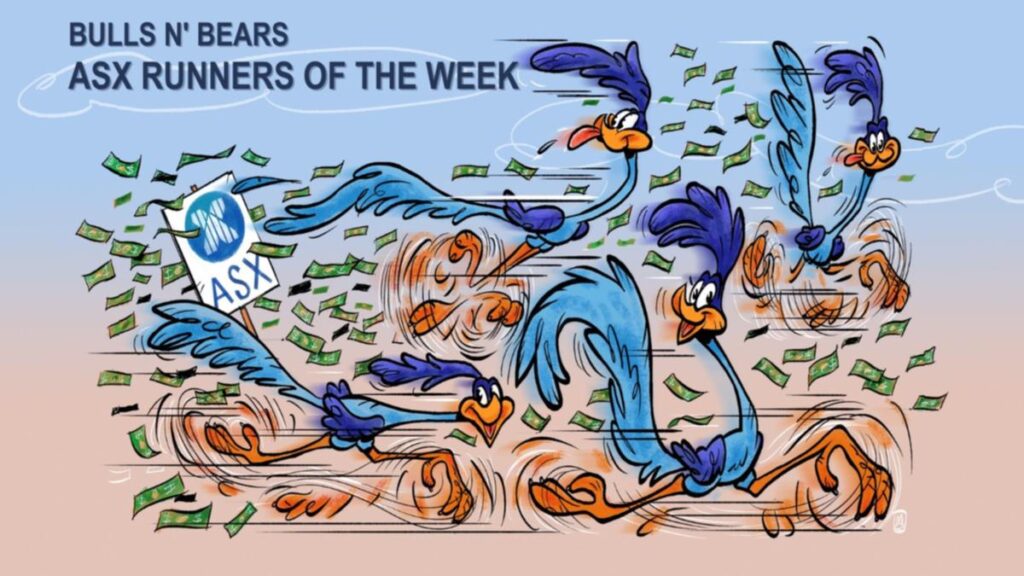“Ahhhh stability” – or at least a little relative stability – was welcomed back to the markets this week.
The ASX this week saw some sanity and volume return to trading with the ASX finishing up 1.3 per cent, after a Monday morning sell-off fuelled by Friday losses from the escalating China-United States trade war.
Following China’s retaliatory export restrictions on rare earth elements used in defence, energy and automotives – of which China controls some 97 per cent of production for the majority – US President Donald Trump launched a probe into the need for tariffs on critical minerals this week.
Underestimating just how dependent dozens of US defence and aerospace companies are on China’s rare earth products, the US will perhaps have to look elsewhere for its rare earths. China currently meets 70 per cent of US demand.
The probe’s announcement saw Australian rare earth and critical minerals stocks take off, securing a stranglehold of two of our four Bulls N’ Bears Runners spots on the short week.
Despite the subdued quiet in markets before the Easter long weekend – relative to the past couple of months – gold continued its legendary march passing US$3000 an ounce just weeks ago to reach a staggering US$3350 per ounce this week.
The yellow metal’s dominance should not surprise to Runners readers by now but for a country that possesses the most gold reserves in the world, it is a seriously big deal.
Having said that, the Bulls N’ Bears Runners list does not feature a goldie this week, as rare earths understandably stole the show. The top spot was again awarded to an unlikely all-comer – an Aussie oil and gas minnow that secured an option over a mammoth-scale oil prospect in Africa.
GRAND GULF ENERGY LTD (ASX: GGE)
up 167% (0.15c – 0.4c)
This week’s Bulls N’ Bears ASX Runner of the Week is oil and gas exploration company Grand Gulf Energy, which saw its share price go up today after the company announced a binding option agreement to acquire a potential 1.1-billion-barrel oil prospect in the Walvis Basin, in offshore Namibia.
Offshore Namibia is one of the hottest addresses globally for oil and gas exploration and more than 11 billion barrels of oil have been discovered in the past three years.
Oil and gas super majors active in the region include Shell, Chevron, TotalEnergies and GALP, offering abundant potential suitors for funding arrangements for the seven wells Grand Gulf has planned for 2025.
The fanfare and ensuing 167 per cent share price jump on Monday, from 0.15 cents to a peak of 0.4c. This was on the back of an option, over an offshore Namibia application, which still hasn’t been approved and must then be converted into a petroleum exploration licence.
There is a solid chance it could remain pending for some time and, perhaps, not be permitted at all.
That didn’t hold some punters back – $220,000 worth of stock traded to open the week. Small-cap oil exploration is about as akin to high-stakes gambling as an investor can find. A successful well can yield multiples in returns, but the more common outcome – a dry well – can nearly wipe out an investment.
The exploration block in question covers 16,800 square kilometres in water depths from 1400 metres to 2000m and lies to the south of the Murombe-1 and Wingat-1 wells.
The company executed an accompanying $700,000 placement over the weekend to professional and sophisticated gamblers at an issue price of 2c per share. The funds will likely go towards the company’s working capital and ‘evaluation’.
METEORIC RESOURCES (ASX: MEI)
Up 101% (6.7c – 13.5c)
Meteoric Resources led the rare earths charge this week, taking out second place on the Runners list after the company unveiled a maiden mineral resource estimate for its Barra do Pacu (BDP) licence within its Caldeira ionic clay project in Brazil.
The company’s rare earth project falls under the ionic clay classification, a notably cheap-to-exploit mineralisation. To date, it is only the second type of mineralisation – outside of carbonatites such as Lynas Resources’ world-class Mt Weld deposit – to be successfully mined.
The maiden mineral resource estimate at BDP came in at a substantial 389 million tonnes grading some 2204 parts per million (ppm) total rare earth oxides (TREO), including a high-grade indicated resource of 32Mt grading 4130ppm TREO.
Meteoric’s global Caldeira resource now sits at a whopping 1.5 billion tonnes grading 2359ppm TREO of critical rare earth oxides, including 195,000t yttrium oxide, 195,000t praseodymium oxide, 554,000t neodymium oxide and 65,000t samarium oxide. Yttrium and samarium have both been targeted by China.
The company’s share price ran throughout the week to close on Friday up more than 100 per cent at 13.5c per share from a close last week of just 6.7c per share.
Meteoric says its broader global resource contains all the banned Chinese rare earths, except for scandium. The company believes the project could be the next low-cost production alternative outside of China, which it outlined in an initial scoping study in July last year.
Rare earths producers have had a tough time of late. When the world-class Mt Weld project in Western Australia can barely stay afloat, it becomes evident rare earths are decidedly not that rare at all. However, demand for the critical minerals is increasing and non-Chinese alternatives are a must for the US to stabilise supply.
AUSTRALIAN STRATEGIC MATERIALS LTD (ASX: ASM)
up 97% (39c – 77c)
Australian Strategic Materials (ASM) got on a run early this week prompted by Trump’s rare earths dilemma, and the all-knowing ASX booked the company with a speeding ticket on Monday, apparently unaware of why its share price was running.
ASM responded it was not aware of any unknown information, however the company noted that thanks to China’s increased export restrictions, it was uniquely positioned to deliver a broad portfolio of rare earth products from ore through to alloy outside of China’s influence.
The share price ran up 97 per cent by Friday to top at 77c from a close of 39c last week on a very handy $5M in stock traded.
Many of the materials affected by China’s new export restrictions are already available or planned through ASM’s alternative supply chain, offering its partners a viable, de-risked solution in the company’s Dubbo project in New South Wales.
ASM has been investigating alternative lower capital and shorter implementation options to recover light (neodymium and praseodymium) and heavy (dysprosium and terbium) rare earth elements from the Dubbo project.
The company says Dubbo is construction-ready, with all its major permits approved. Dubbo currently contains an estimated 75.18Mt resource at ore grades for heavy rare earths, zirconium, niobium and hafnium.

NEUROSCIENTIFIC BIOPHARMACEUTICALS LTD (ASX: NSB)
Up 97% (3.5c – 6.9c)
NeuroScientific Biopharmaceuticals took out the final spot on the ASX Runners of the Week list, after the neurodegenerative pharmaceutical innovator made a shrewd pickup of the stem cell company, Isopogen WA.
Isopogen WA holds the rights to utilise its patented StemSmart stem cell technology, which is used to produce a life-changing cellular medicine.
StemSmart cells interact with a patient’s immune system to modulate its response to inflammation. The cellular medicine technology uses cells from adult bone marrow and is grown in culture.
The Isopogen acquisition sent NeuroScientific’s share price soaring today to peak a huge 97 per cent on the day to 6.9c on $650,000 of stock traded.
The company says early indications from a phase two trial in a type of Crohn’s disease, which affects the gut, suggest the StemSmart technology is a potent, efficacious and safe therapy suited to a globally massive market.
Crohn’s disease is a type of inflammatory bowel disease, with a global treatment market estimated to be worth US$13.8 billion by 2026.
As a result of the acquisition, NeuroScientific had completed a placement to raise $3.5M at 3.5c a share through the boys and girls at Westar Capital. The biotech company hopes the raise will help it to exploit the next powerful technology in regenerative medicine.
NeuroScientific believes stem cell therapy is a cornerstone of modern medicine. Stem cells have a unique ability to develop into any cell in the body. The stem cells are hailed as the body’s master cells. This week’s acquisition could potentially be a master stroke by Neuroscientific.
Is your ASX-listed company doing something interesting? Contact: matt.birney@wanews.com.au



